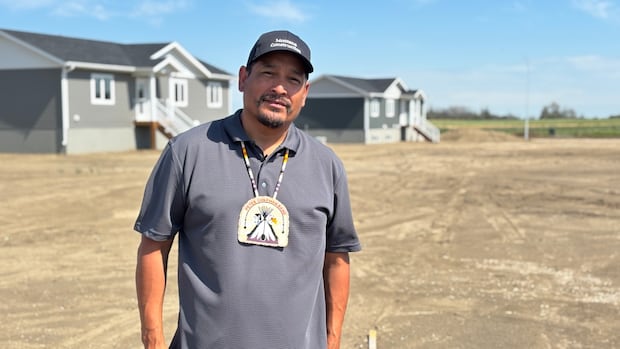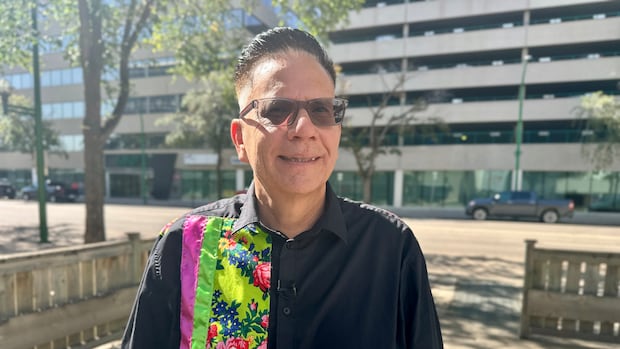In central Saskatchewan, surrounded by fields of wheat, Adam Whitehead is showing off some of the newest homes in Peter Chapman First Nation — home to a development boom as it builds a new community from scratch.
“This was just a canola field a year and a half ago,” he said, looking out at a new gravel road lined with 14 homes. “Our vision as the whole community was to get a solid foundation for the next generation.”
Whitehead, a councillor for the Cree community, is taking part in the decades-long fight for it to get recognized as an independent band by Canada. In the eyes of the federal government, it’s still part of James Smith Cree Nation more than a century after a forced merger.
The community is using $50 million from a treaty land settlement with the federal government to build a new community, as part of a renewed push for independence. Construction is underway on a new band office, public works garage, sports fields and a subdivision with 28 houses.
“We’re trying to correct the mistake that they made,” said Whitehead, on a tour of the new housing development. “We’re not stopping until the government finally realizes that we’re an independent band.”
‘Stripped from our own community’
The ancestors of the Cree community’s residents arrived in the area in the 1880s from Cumberland Lake in northeast Saskatchewan, relocating with their leader Peter Chapman in search of better land for farming.
The Cumberland Band, as it was known, signed Treaty 5 in 1875. In 1889, it received land as part of the establishment of a new reserve adjacent to James Smith Cree Nation and became a recognized First Nation band.
But in 1902, the community was forcibly merged into the James Smith Band by the Indian agent at the time, according to government records.
Peter Chapman Chief Robert Head said his ancestors came to the Fort à la Corne area to start a new band — with no interest in joining existing ones. But amalgamation made it easier for the federal government to take and sell reserve lands for profit.
“We were our own people. We had our own government and we had our own membership,” he said.
Peter Chapman First Nation Chief Robert Head says his community’s independence was erased more than 100 years ago when it was forced to merge with two other groups. He’s hoping Canada will acknowledge that, recognize their nationhood and allow them to move forward.
Head said independence would finally allow his community to have funding agreements with Ottawa for services like health care and education.
“They should have allowed us to evolve as our own First Nation, but all that was taken away from us,” he said. “This step towards reinstatement is the final chapter in our history — where we’re finally recognized and finally able to take on our own affairs as a nation.”
A third band, Chakastaypasin First Nation, was also merged after having its land taken away, the documents show. The three original reserve lands bordered each other.
We never created this. Canada created it.—Chakastaypasin Chief Calvin Sanderson
Chakastaypasin Chief Calvin Sanderson said the push to regain recognition has been long and slow.
“We never created this. Canada created it,” he said. “We signed treaties and yet we were stripped from our own community.”
Chakastaypasin is also using its share of the treaty land entitlement settlement to build new housing on the James Smith reserve, and non-reserve land it purchased south of Melfort.
Sanderson said the lack of status and land has prevented the community from accessing direct funding for much-needed housing. He hopes that will soon change.
“It’s a long hurdle and very stressful. But that light at the end of the tunnel is coming and hopefully we can light that candle once and for all,” he said.
“I’m glad that we never gave up our vision because it’s the next generation now that’s going to be flourishing.”
Renewed push to split
The combined membership of all three communities voted in 2000 to restore and reinstate the original bands, electing three chiefs and political representation for the first time in nearly a century.
In a second referendum, they voted overwhelmingly to proceed with splitting up government, land, funding and assets.
But the pathway to recognition from Ottawa has been slow.
All three chiefs have launched a renewed push this year, signing a document to formally divide James Smith Cree Nation into three distinct and recognized nations — a step they describe as a “major milestone.” The agreement was delivered to the federal government in July and talks are underway with Indigenous Services Canada.
Jacinthe Goulet, a department spokesperson, confirmed the three communities are engaged in a process seeking formal recognition as separate and distinct bands under the Indian Act.
“The process will be handled with careful consideration,” she wrote in an emailed statement. “It is premature to speculate on the details of possible outcomes or the potential timelines at this stage.”
‘It’s going to become a reality’
At Peter Chapman First Nation’s bustling development site, staff and leaders are already working out of a brand new band office — the community’s first. The modern building has large windows looking out on quiet prairie fields and the walls are decorated with brightly coloured paintings by a community artist.
Until recently, its chief and councillors shared space with James Smith Cree Nation.
For elder and former chief Phyllis Head, it’s a promising sign of the future for the Peter Chapman band.
“We’re going to finally have our own land and our own reserve and our own saying of how we want to live,” she said.
Head said her band was always the smallest of the three within the James Smith community, making it more challenging to secure jobs on reserve and have a say in decisions about housing and infrastructure projects.
Becoming an independent band would allow the community to access Ottawa funding without it flowing through James Smith leadership first.
“We have a lot of band members that live in urban centres and they’d really like to come home,” she said.
“For many, many years this issue has been worked on and it’s going to become a reality.”
For Adam Whitehead, the new homes built in less than a year are proof the vision of an independent First Nation is already a step closer to becoming a reality.
On the tour, he showed how each new property was built with high-quality materials and durable insulation to prevent mould, which is often a problem in on-reserve housing. The majority of the homes are also built to accommodate large families, with as many as six bedrooms, to avoid overcrowding.
Families are expected to move in this September, with ball diamonds, a track, an arena and a park being built right across from the backyards.
Whitehead, who lives off-reserve due to a shortage of housing, hopes to return himself one day — once it’s his turn on a growing waitlist.
“I think it’s our right to be our own community,” he said. “It’s just a matter of time.”








